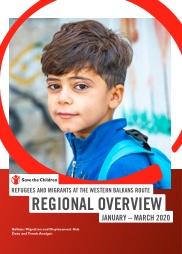
Balkans Migration and Displacement Hub Data and Trend Analysis: Regional overview (January-March 2020)
Publication year:
2020
English
Format:
pdf (3.2 MiB)
Publisher:
Save the Children International,Save the Children North West Balkans
Data and Trend Analysis (DATA) Refugees and Migrants at the Western Balkans Route Regional Overview, covering period January – March 2020, describes key trends in migrations in the region, detailing information about the number of people on the move, demography (age, sex, country of origin, etc), behavioral patterns, and routes in use – with a focus on children, particularly unaccompanied children.
Key trends showcased in this report:
- Even with the emergence of the COVID-19 crisis, the migration route through the Balkan countries continues to be the most traveled route to Europe with at least 9,834 newly arrived migrants and refugees registered during the first quarter of the year.
- More than 138,500 refugees and migrants were present in the Balkans in the reporting period.
- COVID-19 crisis-affected migration flows. Closed borders were one of the factors resulting in the decrease of new arrivals in the second half of March. Covid-19 prevention measures included a restricting movement from most refugee and migrant camps. The closed access to camps increased health and protection risks for refugees and migrants, fueled the fears among refugees and migrants, and led to many incidents, fights, and fires in the camps, increasing the risks for children and for staff still in the centres. Hostility against refugees and migrants increased among the host communities.
- A greater proportion of families, most often from Syria and Iraq, are on the move when compared to the first half of 2019, while the number of refugees and migrants from African countries is increasing on the Western Balkans route.
- Bosnia and Herzegovina remained the main intersection used by refugees and migrants traveling through the Balkans. Routes through Romania and Albania/ Kosovo* are increasingly used.
Read full abstract
Authors
View & Download
Document information
Authors
Format
Country
Region
Topics
Rights
© Author/Publisher
Found a mistake? Help us improve!
If you have noticed a document assigned to the wrong author or any other inaccuracies, let us know! Your feedback helps us keep our data accurate and useful for everyone.
Share
Link

